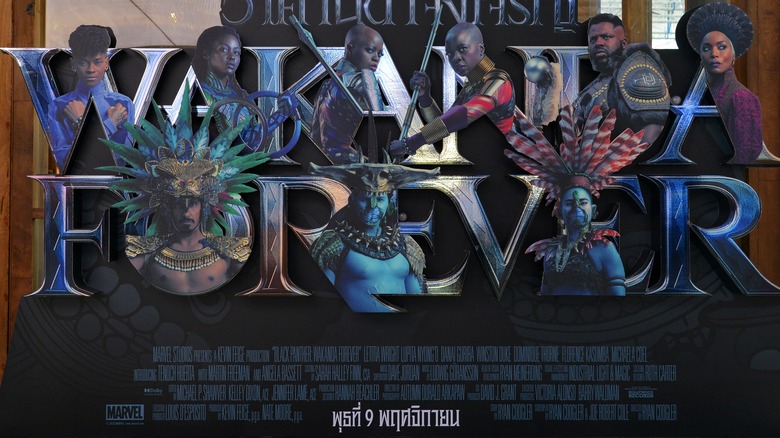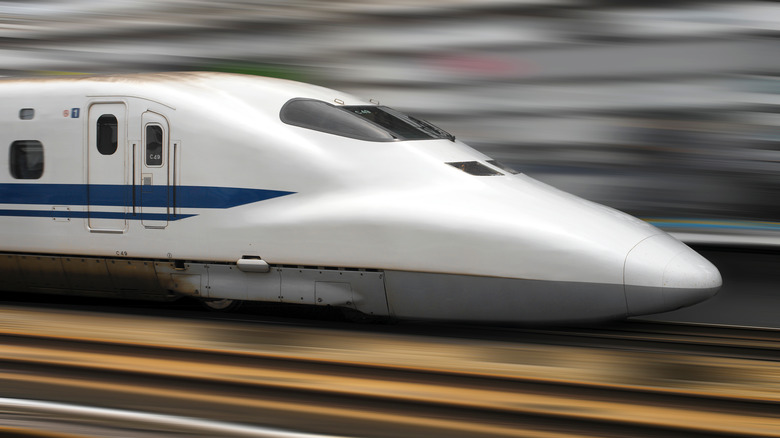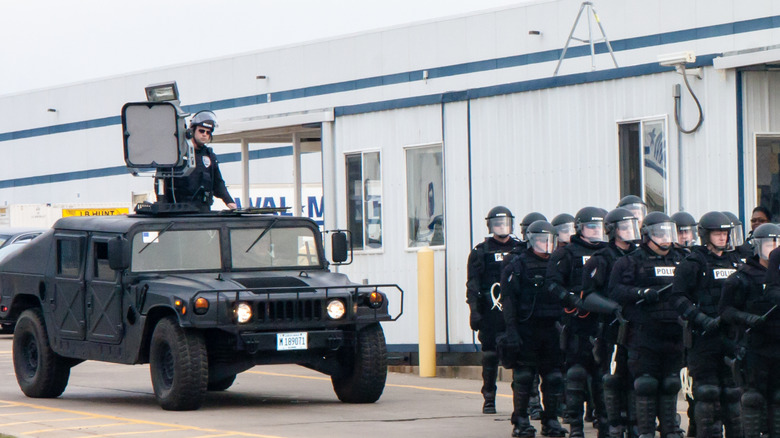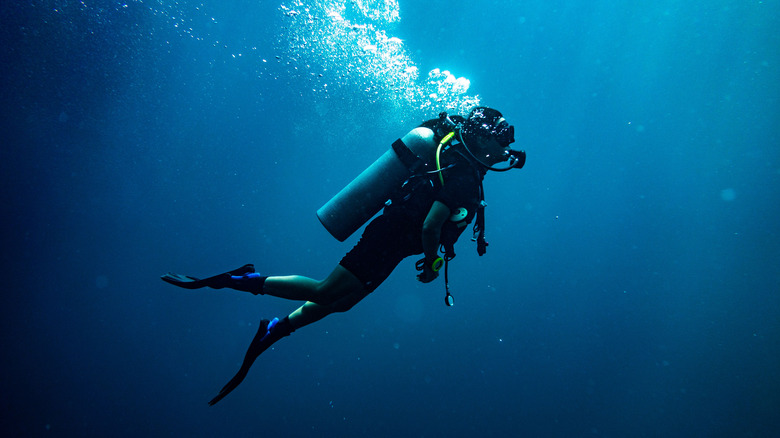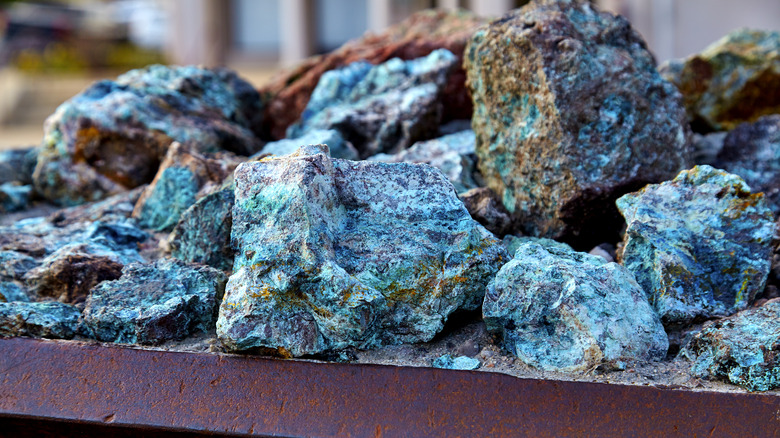Here's What Makes The Tech In Black Panther 2 So Realistic
As with the first movie, Black Panther II: Wakanda Forever contains highly advanced technology. Wakanda itself is supposed to be a hyper-advanced society, leaving other nations trailing in its technological wake. Its incredible advancement is aided by its supplies and use of vibranium — a rare metal with almost magical properties. Vibranium can function as highly effective armor, generate power, and perform a wide variety of other tasks. As a result, demand for the metal is quite high and other nations trying to get their hands on it has been central to the plot of both movies.
While Wakanda's tech may seem far-fetched, just as with the first movie, a lot of it has a strong basis in reality. Some of it is even decades old. Yes, the Marvel Movie version is better in some cases, and some of it may still be a few years away in the real world, but it's easy to see where a lot of the writers' inspiration came from when looking at certain Wakandan and Talokanil devices. This article contains some spoilers, so if you haven't seen "Black Panther II: Wakanda Forever" and don't want any of the plot unveilings, you may want to give it a watch and come back later.
You don't need a vibranium detector to find metals underwater
The central plot of "Black Panther II" centers around the discovery of vibranium on the sea bed thanks to a device made by a student from MIT. While there may be no vibranium to detect in real life, scientists do believe the sea floor is littered with precious metals that governments and corporations are looking to exploit. The amount of gold alone believed to be under the oceans is staggering. According to National Geographic, there is an estimated $150 trillion worth of the precious metal that could be harvested if we work out a way to mine below the deep waves. Other metals including silver, copper, and cobalt are also likely to be dug up from the deep if the underwater mining industry takes off.
Finding those precious metals is a bit more low-tech than using a "scanner," but it still involves some cutting-edge machinery. A remotely operated vehicle is dispatched to potential mining sites to gather samples and bring them back to the surface. The samples are then analyzed to give a good idea of what minerals might lie beneath the surface. While real-life underwater mining is unlikely to disturb an Atlantis-like civilization and start a war — it isn't straightforward either. There are vast geological and political implications currently being debated and researched. Some campaigners have claimed the environmental impacts of ocean mining are "totally unknown," while others have pointed toward the devastating effects it could have on ocean life.
Wakanda's public transport system has existed for decades
Wakanda's high-tech public transport system is central to how it functions as a nation. The Maglev trains are used for public transport, moving freshly mined vibranium, and the occasional fight scene. They're also arguably the most reality-based examples of tech used in the movies. Maglev systems are far older than you may think, and patents for similar transport were filed over a century ago. The most famous example of maglev being used for transportation is probably Japan's "Bullet Train" which can take passengers between cities at speeds of up to 374 miles per hour. The first Maglev train made its maiden journey back in the 1980s, but the pioneering vehicle wasn't moving a miracle element around a highly advanced African nation. It was actually transporting travelers between the center of Birmingham, England, and the city's main airport. Although it was certainly groundbreaking, Birmingham's Maglev train wasn't as fast and impressive as Japan's or Wakanda's — capping out at around 26 miles per hour.
The concept could also be taken further. The idea of a "hyperloop" has been bouncing around for years. The most famous recent example is Elon Musk's whitepaper on the topic, which suggested building a hyperloop between Los Angeles and San Francisco. The Hyperloop uses the Maglev principle to reduce friction but combines it with a vacuum tube to take away air resistance as well. If the concept becomes a reality, the hyperloop's carriages could hit speeds of 760 miles per hour. Musk believes the hyperloop could also be powered by green energy if part of the route is lined with solar panels, making it a potential carbon-neutral alternative to air travel.
Mark I and II Ironheart Armor isn't too far fetched
In "Black Panther: Wakanda Forever" Riri Williams dons the Ironman-inspired Mark I Ironheart Armor to take on the Talokanil. The suit gave Williams the ability to fly and boosted her strength, while also making her resistant to bullets, blasts, and other forms of attack. While the technology needed to make an actual Ironheart suit is a long way off, elements of it are already being tested by militaries around the world. The Royal Marines were filmed testing a jet suit that provides similar flight capabilities to the Ironheart armor. In the video, the Marines were seen flying from a small boat to a larger ship and back. Exoskeleton projects, which provide the people inside them with superhuman strength, are a well-established area of research. The U.S. Navy purchased Guardian XO, which will allow a user to easily lift up to 200 pounds, back in 2019.
Combine those two with some effective armor plating and you essentially have a primitive Ironheart suit. The concept is something the U.S. army takes pretty seriously, and they have been working on what is basically an Ironman suit since 2013 at the very least. TALOS is a combination of an exoskeleton system, "innovative armor," displays for power and health monitoring, and some kind of integrated weapons system all rolled into one. While vibranium isn't real, there is still potential to create something that could be a game-changer on the battlefield using other elements we have kicking around on Earth.
Sonic weaponry is a thing, but isn't as compact
"Black Panther 2: Wakanda Forever" features an interesting mix of weaponry, and not all of it is reliant on blades and bullets. The Sonic Rifle and Vibranium Gauntlets use soundwaves to take down enemies, and the real world has had similar weapons for decades. Modern sonic weapons tend to be non-lethal and are a go-to for things like riot control. A popular sonic weapon in use today is the Long Range Acoustic Device (LRAD) which can incapacitate everyone within 100 yards. The LRAD is capable of using high-frequency audio to cause nausea, fatigue, disorientation, and physical pain (via VHR). If it's ramped up to around 140 decibels, it can also cause permanent hearing damage. Units weigh from 15 to 320 pounds, and some are mounted on vehicles. Within the United States, LRADs, which are also known as "sound cannons" have been used to quell civil unrest during events like the 2009 G20 protests — though their use has also caused some controversy (via the Guardian).
At a more basic level, sound-based weaponry has been used to inspire terror among an enemy. During World War Two, a device known as a "Jericho Trumpet" was fitted to the German Stuka Ju-87 planes. The planes were dive bombers, and every time they dipped in to attack a target, the blasts would be preceded by a terrifying sound designed to demoralize those below. During the Vietnam War, the U.S. Military developed "ghost tapes" which contained the "wails, moans, and anguished cries in Vietnamese" edited to sound like they were being made by ghosts. The tapes would then be blasted from helicopters during the night in an attempt to break the resolve of North Vietnamese troops.
Talokanil Respirators aren't as complicated as the real thing
The Talokanil were forced to live in the water after eating vibranium-laced plants and growing gills centuries ago. As every goldfish owner knows, animals relying on gills to breathe don't do too well in the open air. But the Talokanil are human and capable of inventing things, so they worked out a way around that. The former Mesoamericans wear their own type of respirators when conducting business on land. In the real world, respirators do the opposite and do it very well.
Respirators require some training to use (via Scubadiving.com) but allow divers to navigate the briny deep without drowning. Before they were invented, humans could last a few minutes beneath the waves before surfacing. Now, they can stay under for as long as their oxygen tanks allow. Real-life diving systems are arguably more complex than the Talokanil equivalents. The conditions of a dive change depending on how deep you go, and what is in your oxygen tank has to change with it. Regular air contains upwards of 79 percent nitrogen, and that's fine to use if you're only diving down to about 130 feet. As Scuba Diver Life explains, go any deeper than that and you'll need to change up your mixture. Nitrogen actually becomes narcotic as you dive down deeper, so the oxygen content is sometimes ramped up or helium substituted depending on the exact needs of the dive. As the gas is pressurized, a regulator is also needed to make sure it is being released at a pressure you can breathe and not unleashed with enough force to burst your lungs.
Talokanil Water Bomb
The Talokanil's most distinctive weapon is arguably the "water bomb." The objects, which are slightly smaller than soccer balls, erupt into a large amount of water capable of blasting people aside and flooding an area. The underwater nation also manages to flood Wakanda's capital, Birnin Zana, during its attack on the African kingdom. You can make your own, albeit less effective, water bombs at home with a balloon and a faucet. Water has also been used in warfare for a long time.
During World War Two, the British put a tremendous amount of effort into developing a bomb that could be used to destroy dams, inhibit electricity production, and flood large areas of enemy territory. As the Imperial War Museum explains, the Dambuster's Raid was one of the most iconic missions of the Second World War. It didn't inhibit German production as much as the Allies had first hoped, but the raid did provide a huge morale boost and propaganda victory. As you may expect from them, the Americans tried to take things a step further. In collaboration with New Zealand, Uncle Sam tested out a "Tsunami Bomb" which they estimated could create 33-foot high waves capable of destroying a small city (via the Telegraph). The plan was feasible, and ten well-placed offshore blasts could produce the desired effect. However, the "Tsunami Bomb" never made it beyond the development phase and the United States decided to end the war with a different top-secret, city-obliterating, doomsday weapon instead.
Vibranium is real, sort of
If you've been paying close attention to this article you may have noticed the words "vibranium isn't real" used a few times. Well, the Marvel universe's magic metal isn't apparent in our universe, but one notable element does come close in several ways. Cobalt is a rare metal that is central to modern technology. Without the substance, we wouldn't have cellphones, lithium-ion batteries, the laptop this article is being written on, or a multitude of other modern conveniences. It's also used to make a number of hard-wearing alloys — though kevlar and ceramics are still the real-life go-to choices for body armor. Just as most of the world's vibranium is concentrated in Wakanda, most of the world's cobalt happens to be in the Democratic Republic of Congo.
However, the Congo lacks a cloaking device, so most of its cobalt tends to be exported for use in factories around the world. As The New York Times explains, the Congo's vast cobalt reserves haven't turned it into a technological powerhouse either. The country's mining industry has been a source of exploitation for over a century. Despite current global attitude trends toward giving small children jobs in heavy industry, keeping technology prices down may be enough to keep the world collectively looking the other way in this case. Modern lithium batteries can contain up to 30% cobalt, though this could change as scientists look toward cheaper, more ethical, alternatives.
